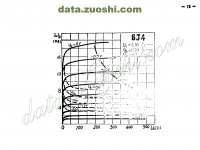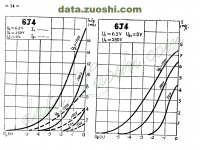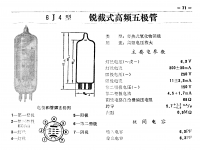Attached is a schematic of a preamp selling in kit form on ebay from a well known Chinese store which many of you have probably seen, and which i was thinking of buying and upgrading.
I have a reasonable understanding of amplifiers and schematics and can build from scratch however my understanding of topology and theory/design of amps is very basic, is there anyone who can look at this circuit and give my some feedback on its design and how it might be improved.
It would pair with and Aleph J power amp.
Many thanks

I have a reasonable understanding of amplifiers and schematics and can build from scratch however my understanding of topology and theory/design of amps is very basic, is there anyone who can look at this circuit and give my some feedback on its design and how it might be improved.
It would pair with and Aleph J power amp.
Many thanks
The 6J4 is a triode and drawn incorrectly, (no surprise there as it is Chinesium after all). Who would want to use a 6V6, output valve, as a pre amp ... apparently these guys do.
Improvements ... sorry but almost anything will improve it. Take your pick but start with a design that uses quality valves, not junk.
Improvements ... sorry but almost anything will improve it. Take your pick but start with a design that uses quality valves, not junk.
Not necessarily.I know people wiring some pcf pentodes that way and they never got bad results...The 6J4 is a triode and drawn incorrectly,
Is the design worth upgrading with decent caps and have you any recommendations for alternative tubes
Maybe with the right valued caps more...like 22...220uF instead of 2.2uf...the final tube is way more potent than how they chose to use it...proper power supply and you can get a lot of transconductance out of it with the right anode and cathode resistors to drive anything...
Last edited:
6Ж4П 6J4P is a Soviet 6AU6 actually... Chinese 6J4.The 6J4 is a triode and drawn incorrectly, (no surprise there as it is Chinesium after all). Who would want to use a 6V6, output valve, as a pre amp ... apparently these guys do.
Improvements ... sorry but almost anything will improve it. Take your pick but start with a design that uses quality valves, not junk.
As far as 6V6 for a preamp? I'm sure you've seen Salas's 6V6 Preamp thread? https://www.diyaudio.com/community/threads/6v6-line-preamp.102352/
Many people seem to like using 6V6 as a preamp tube.
http://file.tubebbs.com/attachments/day_130610/1306102222a65975bdd2c80473.jpg
6j4 is shown as triode strapped pentode as below:
http://data.zuoshi.com/audiodata/cn/sg/6J4_Curve.png
https://www.sgss8.com/tpdq/20446625/2.htm
6j4 is shown as triode strapped pentode as below:
http://data.zuoshi.com/audiodata/cn/sg/6J4_Curve.png
https://www.sgss8.com/tpdq/20446625/2.htm
Attachments
Chinese tube brand like Shuguang is actually a Korean investment at the time when Chinese don't even make tubes, they were imported until WW1/WW2 as the Nationalist stopped or jailed anyone buying foreign tube. Now Chinese should make everything better for these reasons.
Last edited:
Do you actually need any line stage gain? Do you need a phono stage?Thanks for the feedback, any suggestions for a good, simple pre
What are your sources and amplifier?
Nobody's commented on the NFB loop from plate of 6V6-triode to 6AU6-triode. That's a 'Ring of Two' topology.
The 6AU6-triode is 'lifted' by a 2k resistor underneath its signal ground connection, to reduce gain through cathode degeneration (current feedback).
Why would you reduce the gain that way, only to reduce it more with a NFB loop? It would be technically better to ground the 6AU6-triode Rk (330R) to get all the gain you can from the first stage (roughly 30x) and reduce the total gain to your needs using the NFB loop.
The 6AU6-triode is 'lifted' by a 2k resistor underneath its signal ground connection, to reduce gain through cathode degeneration (current feedback).
Why would you reduce the gain that way, only to reduce it more with a NFB loop? It would be technically better to ground the 6AU6-triode Rk (330R) to get all the gain you can from the first stage (roughly 30x) and reduce the total gain to your needs using the NFB loop.
sources are dac 2v, phono 0.4v, power amp is Aleph J, 1.5v, so some gain is needed for phono. I did build a transformer attenuated passive pre using Sowter txs, with 0 or 3db gain for use in a previous system and worked fine with 3db gain into parallel 300b monoblocks, but these were driving very efficient Lowther full range.
Sadly i had to get rid of that set up and now built the Aleph J driving not so efficient Fostex full range, i am tempted to build the passive again but it is relatively costly and was looking for cheaper alternative
Sadly i had to get rid of that set up and now built the Aleph J driving not so efficient Fostex full range, i am tempted to build the passive again but it is relatively costly and was looking for cheaper alternative
some gain is needed for phono
That is often the case.
One solution would be to build a little gain block to bring the level of the phono output up to that of the DAC. It's possible to make a simple line level amp with 4x to 6x gain, but you will most likely need to employ a bit of NFB. Many people are completely allergic to that. So that would be the first question: Would you be willing to make a line level amp that uses NFB?
If no, then you'll want to look at simple low-mu triodes. Salas' 6V6 preamp comes to mind, but that would have 8x or so of gain, which would likely be too much. Perhaps a simple common-cathode 12P17L-triode preamp? Or an EL86-triode?
However if you are willing to employ some NFB, then there are more possibilities. I was looking to boost the output from a Hagerman Bugle and warm it up a little, so I built a 6DJ8 'anode follower' (inverting common-cathode stage with plate-grid shunt feedback loop). It was a quick lash-up with a poor PSU, but it gave me what I was looking for. Were I to do that again, I'd buffer the output and use a higher voltage and cleaner B+ supply. At these high signal levels I think an AC heater supply would be fine, assuming careful layout.
The Chinese 6J1-triode/6P6P-triode preamp you posted uses NFB in a 'Ring of Two' configuration (feedback signal is taken from the plate of the inverting output stage to the cathode of the inverting input stage). I don't know if that exact circuit is the best possible for this application, but you could probably make it work, as long as the PCB is good. The user manual for the Aleph J claims the amp's input impedance is 242k ohms. That is a quite easy load to drive.
If you search for 'tube preamp' I'm sure you'll find scores of possibilities.
Cary AE-1 knock-off - https://www.ebay.com/itm/164568229374?hash=item265107e5fe:g:nlUAAOSwKethQbsQ
(Non-inverting. Grounded grid, cathode coupled amplifier first stage, to cathode follower output stage, with NFB from output to 1st stage grounded grid.)
These circuits are so simple, you could build from scratch.
I was thinking of something like this (just an example, not a final design). Gain of about 3X. Low output impedance. It does invert polarity, though.
Great, thanks alot for your advice, i have no problem with NFB, why not, it seems to have many advantages, with not much downside.
I was also looking at this (or similar low mu) on Ale Bartola site anyone any experience with building any of these?
https://www.bartola.co.uk/valves/dht-pre-amplifier/01a-preamp-gen2/
I was also looking at this (or similar low mu) on Ale Bartola site anyone any experience with building any of these?
https://www.bartola.co.uk/valves/dht-pre-amplifier/01a-preamp-gen2/
Last edited:
You are basically correct. However, the 330R and 2K resistors in the cathode of the first tube form the bottom half of the NFB network. With the 24K feedback resistor this gives a closed loop gain of approximately 12 times. If you remove the 2K, you need to change the 24K feedback resistor to 3K6 which is almost certainly too heavy a load for the output stage. Like all engineering it is a compromise.Nobody's commented on the NFB loop from plate of 6V6-triode to 6AU6-triode. That's a 'Ring of Two' topology.
The 6AU6-triode is 'lifted' by a 2k resistor underneath its signal ground connection, to reduce gain through cathode degeneration (current feedback).
Why would you reduce the gain that way, only to reduce it more with a NFB loop? It would be technically better to ground the 6AU6-triode Rk (330R) to get all the gain you can from the first stage (roughly 30x) and reduce the total gain to your needs using the NFB loop.
Cheers
ian
There is a video in social media (towards bottom): https://www.amazon.com/Nobsound-Vac...01N656HHD/ref=cm_cr_arp_d_pl_foot_top?ie=UTF8 and review https://www.amazon.com/Nobsound-Vac...show_all_btm?ie=UTF8&reviewerType=all_reviews
It does not sound too bad, but at least one person doesn't like it.
The problem could lie in the 1st stage where local and global feedback are applied together which may conflict with each other. My sim show that the more gNFB applied the more is THD%, the higher being the higher order from 4th and up, so there is a limit of gNFB can be applied(?), how does it affect listening?
It does not sound too bad, but at least one person doesn't like it.
The problem could lie in the 1st stage where local and global feedback are applied together which may conflict with each other. My sim show that the more gNFB applied the more is THD%, the higher being the higher order from 4th and up, so there is a limit of gNFB can be applied(?), how does it affect listening?
Last edited:
Thanks Ian. That makes sense now.You are basically correct. However, the 330R and 2K resistors in the cathode of the first tube form the bottom half of the NFB network. With the 24K feedback resistor this gives a closed loop gain of approximately 12 times. If you remove the 2K, you need to change the 24K feedback resistor to 3K6 which is almost certainly too heavy a load for the output stage. Like all engineering it is a compromise.
Wouldn't it be better to bypass the 330R resistor (Rk of 6J1) with something like 330uF, and take the feedback from the 'top' of the 2k resistor?
Also, why no bypass cap for the 6P6P Rk (500R)? I'd think lowering the ra of the 6P6P would let it drive the feedback loop a bit better.
And in the end, 12X gain is still a lot for a preamp. Too much for most systems, IMO. That's about the same amount of gain you could get from a common cathode 6N6P or 5687, without any NFB, and that's more gain than Salas 6V6 Preamp.
I agree. I was doing some simulating of some of those 6V6-triode suggestions. If you can make a strong power supply of maybe 400V 60mA and use 15k 12W wirewound plate resistors, 6V6-triode can have really low THD and gain of about 7.5X. Wrap just 5 or 6dB of NFB around that and it will yield around 4X gain and perform very well.directdriver said:do a research in Salas' thread. 6V6 is a great sounding preamp tube. You can always add a tiny bit of feedback to adjust gain.
- Home
- Amplifiers
- Tubes / Valves
- Preamp Circuit Advice


